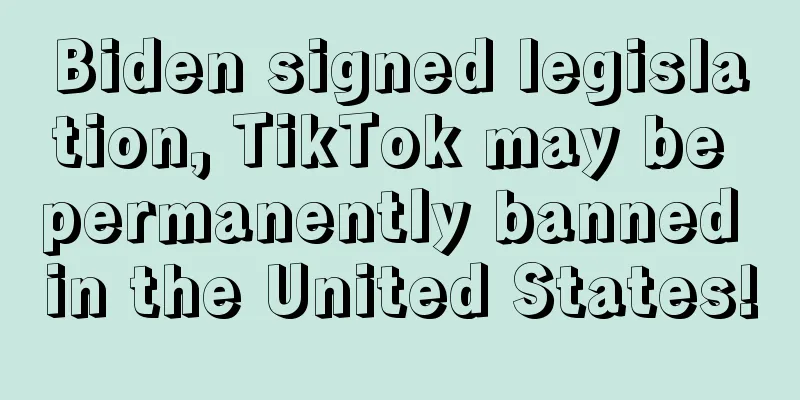After more than a month of controversy over TikTok's divestiture bill in the United States, it was finally settled with Biden's pen. A complete timeline of the TikTok incident (US local time): - On March 5, bipartisan members of the U.S. Congress formally proposed a bill requiring ByteDance to divest control of TikTok within 165 days.
- On March 7, the U.S. House of Representatives Energy and Commerce Committee voted 50-0 to pass the bill.
- On March 13, the U.S. House of Representatives passed the bill with a vote of 325:65.
- On April 20, the U.S. House of Representatives passed a $96 billion foreign aid plan with an overwhelming vote of 360:58. The TikTok-related bill was included in it and the divestiture period was extended from 165 days to 270 days.
- On April 23, the U.S. Senate voted 79:18 to pass the bill and sent it to President Biden.
- On April 24, Biden officially signed the foreign aid plan and the TikTok-related bill
TikTok, which has been on the brink of collapse in the United States several times, has finally come to a critical moment. With only 270 days left in its "life countdown", where will TikTok go in the future? On April 24, local time, the US President announced that he had officially signed a $95 billion foreign aid bill. The bill includes more than $60 billion and $26 billion in aid to Ukraine and Israel, respectively, and also includes the previous TikTok divestiture proposal. Despite TikTok's various efforts over the past month, including calling on users to rise up in opposition and lobbying in various places, the US's determination to impose sanctions seems unprecedentedly firm, and all processes have been moving forward at lightning speed since the proposal was made. Now that the shoe has dropped, it means that ByteDance needs to divest control of TikTok within 270 days, otherwise TikTok will be completely banned in the United States. TikTok seems to be facing two dead ends: either sell or exit. Either way, it will be a difficult decision. But TikTok, which has been forced into a corner, has not given up looking for the last ray of hope. It issued a statement saying that it would resort to legal means to fight back: "We believe that the facts and the law are clearly on our side, and we will win in the end. This ban will destroy 7 million businesses and silence 170 million Americans." After that, CEO Zhou Shouzi He also made a public statement on his TikTok account, assuring users that he would never leave and that he would take legal action to ensure TikTok's normal operations in the United States and firmly defend the rights of all users. Zhou Shouzi also called on users and advertisers to actively defend the platform and demonstrate the value of the platform by sharing their experiences and feelings about using TikTok. It is understood that many content creators strongly oppose the news that TikTok may be completely banned in 2025, because this means that the business that has been operating on the platform for a long time is likely to be wasted. However, the public's call failed to shake the implementation of the bill. In the face of an unprecedented crisis, some industry insiders bluntly said that TikTok should "sell itself" to an American company and find another way out, while others believed that TikTok might temporarily withdraw from the US market and make a comeback when the time is right, just as it did in the Indonesian market before. However, in public statements, CEO Zhou Shouzi has explicitly ruled out the possibility of selling TikTok, and stressed that the proposal to divest the platform to non-Chinese owners is not the real intention of lawmakers. Four years ago, faced with a sudden crisis caused by Trump's executive order, TikTok took up legal weapons and argued for its rights, and finally managed to escape. Today, the situation is even more serious, and TikTok still hopes to see a glimmer of hope through legal means. This is an unprecedentedly difficult battle for TikTok. Prior to this, under the leadership of the United States, countries such as the United Kingdom and Indonesia have successively issued relevant sanctions against TikTok. Therefore, if it fails miserably in this incident, it is likely to cause a series of chain reactions in the future, which will seriously hinder TikTok's global expansion. To date, the United States has become a piece of fat that TikTok cannot give up. According to the Financial Times, ByteDance will achieve revenue of $120 billion in 2023, a year-on-year increase of about 40%. Revenue in the United States reached about $16 billion, a new high, and about 170 million Americans used TikTok throughout the year, accounting for more than 50% of the total U.S. population. The Financial Times predicts that at this rate of revenue growth, ByteDance is expected to surpass Meta and become the world's largest social media platform in terms of sales. According to market intelligence agency Sensor Tower According to data from , TikTok was the most downloaded social media app in the United States in 2023, reaching 47 million times, far ahead of Facebook and Instagram. Faced with a market as large as the United States with strong growth potential, TikTok's global ambitions do not allow it to give in. In its ideal blueprint, it is not only committed to continuing to deepen its position as a social platform in the United States, but also to achieve further expansion through e-commerce business. However, under the current ban crisis, its e-commerce ambitions have also been impacted to some extent. After TikTok Shop was officially opened in the US market, it quickly gained a foothold in the e-commerce industry surrounded by traditional platforms such as Amazon by leveraging its traffic advantages and unique social media attributes. According to data from research firm Yipit Data, although it was only officially launched in September last year, the total GMV of TikTok Shop in the United States is expected to reach US$1.67 billion in 2023. According to FastMoss According to data from TikTok, as of March 2024, the number of TikTok Shop stores in the United States increased by 63.77% from February to 300,000. At the same time, total sales in the United States continued to grow in March, and live streaming with goods showed obvious structural growth. Such impressive results achieved in a short period of time are enough to demonstrate the huge growth potential of TikTok e-commerce in the United States. It is understood that driven by the dividends, the number of merchants entering TikTok Shop has increased significantly in recent months. But now with the implementation of the divestiture bill, many sellers have begun to back off. According to industry reports, some larger brands and businesses planned to withdraw from the market after the House of Representatives passed the proposal with a high vote. A survey initiated by TikTok shows that with the ban looming, 34% of sellers are willing to enter TikTok Shop at this stage, 22% of sellers have no plans to do so, but more sellers are in a wait-and-see state - this figure is as high as 45%. Currently, TikTok Shop in the US is still in its initial development stage. Although the traffic dividend is booming, there are still many uncertainties in its subsequent development. Therefore, for many sellers, they are envious of its current growth potential, but they can't help but question its future fate. With the finalization of the divestiture bill, TikTok has officially entered a 270-day countdown to its survival in the United States. Whether it can survive or not is also a concern for TikTok e-commerce and hundreds of thousands of merchants.
|










